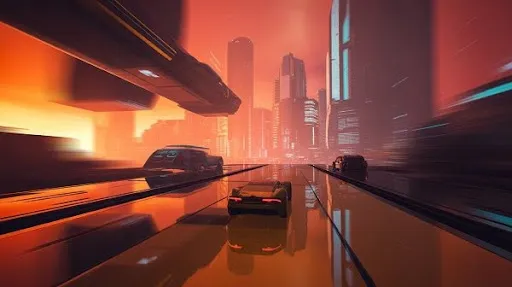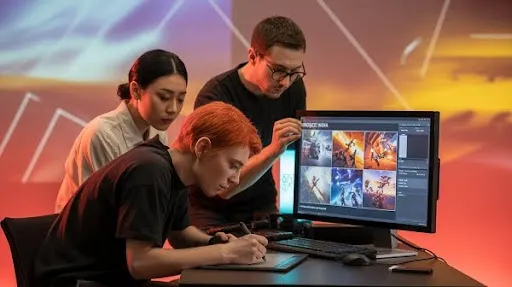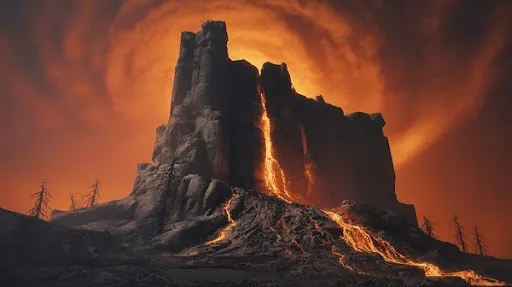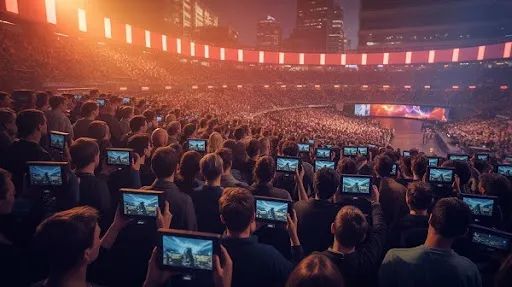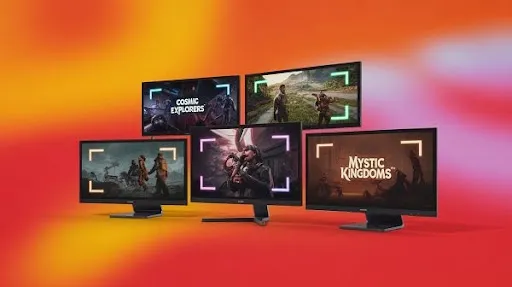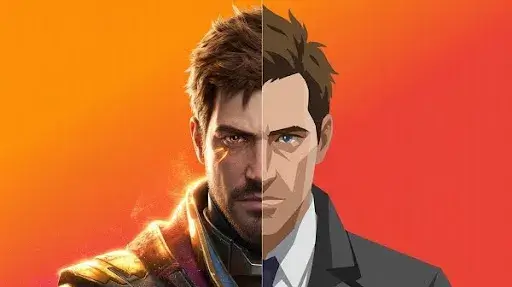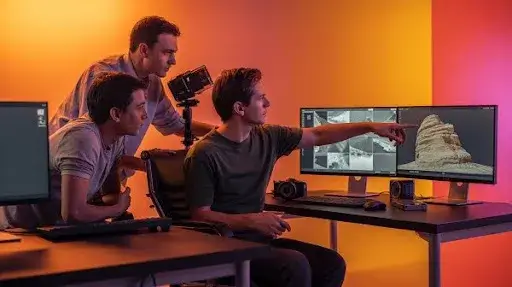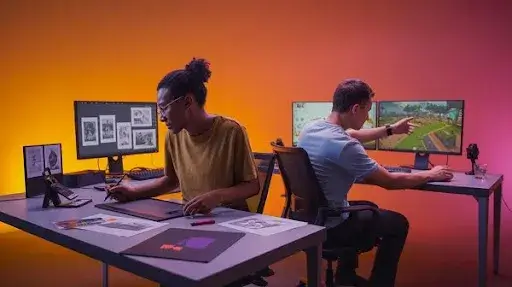Studios can spend half a decade polishing mechanics, sculpting maps, and writing lore. Yet for most players, the first real contact isn’t the game it’s the trailer. Those few minutes of footage often decide if people start buzzing about your release or scroll on like it never existed.
A trailer is more than a flashy preview. It’s a handshake between developer and player, the spark that gets someone to hit “wishlist,” share with friends, or mark the calendar for launch day. With thousands of titles competing for attention each year, learning how to make a game trailer has become a must, not a maybe.
Why Game Trailers Drive Hype and Sales
Gamers want to feel a game before they buy it. Screenshots and press blurbs can’t compete with video. A strong trailer gives them a taste movement, music, atmosphere and that’s often enough to push them toward a purchase. Adding 3D animation services to it does wonders more than you could imagine.
Video marketing isn’t just a theory. Across industries, video sits at the top of engagement stats, and in gaming, it’s even more critical. Make winning video game trailers, and you’ll create buzz that spreads faster than any banner ad. A weak trailer, on the other hand, can sink even a solid title. Players are quick to judge, and once an impression is set, it sticks.
Why Video Game Trailers Persuade So Well
It helps to look at why trailers hit so hard:
- Emotion sticks. Excitement, nostalgia, shock whatever you trigger becomes tied to the game.
- Visuals are sticky. Players remember motion better than text or stills.
- A dash of story builds connection. Even a hint of character or conflict gets people curious.
- Expectation equals value. Polished trailers raise the perceived worth of the game itself.
That’s the magic. A good trailer isn’t just a preview it’s a feeling delivered in a box.
What to Gather Before Making a Trailer
Jumping straight into edits is risky. Strong trailers come from prep work. Before cutting clips together, gather the pieces that will shape the whole thing.
Here’s a checklist worth following:
- Gameplay footage that shows the fun parts combat, puzzles, or exploration.
- Cutscenes and cinematics for context and emotion.
- Concept art or 3D assets when the game isn’t fully polished.
- Audio dialogue, SFX, and chunks of soundtrack.
- Logos and branding to bookend the trailer.
- Storyboard or script so the edit follows a plan instead of guesswork.
Having this pile of material ready lets you focus on experimenting with styles for game trailers instead of scrambling for assets last minute.
Key Ingredients of a Strong Trailer
Plenty of trailers flop because they’re too slow, confusing, or padded with filler. To make greater video game trailers, keep these basics in check.
Mix It Up
Nobody wants two minutes of the same footage looped in different angles. Alternate between gameplay, story clips, and cinematic beats. A surprising cut keeps eyes glued. Animated openers are becoming popular, and live-action sequences used sparingly can really make a trailer stand out.
Nail the Core Focus
Ask one question before editing: Why should anyone play this game? That’s the heartbeat of your trailer. Build around it. If it’s the story, lean into narrative clips. If it’s mechanics, go heavy on gameplay. Trying to show everything at once just muddies the message.
Keep It Tight
There isn’t a universal length, but trailers drag fast if they go past the point. A sharp 90 seconds usually lands harder than a bloated three-minute cut. The trick is pacing: hook them fast, keep the middle varied, and close strong.
Time Your Releases
There are different names for game trailers because each has a role. Reveal trailers introduce. Gameplay trailers prove. Launch trailers convert. Dropping the right one at the wrong time can stall momentum, so match each trailer to the stage of your campaign.
Match the Platform
A Gamescom showcase needs different pacing than a YouTube upload. Loud, bold visuals work in a crowded expo hall. Online, clarity and repeat value matter more. Always cut with the venue in mind.
Why Openings Decide Everything
The opening five seconds make or break a trailer. Gamers click away fast if nothing grabs them.
Good openings usually use:
- A striking image something bold or unexpected.
- A strong line of dialogue.
- An instant action moment that drops viewers right into gameplay.
The first moments are your promise. They tell the audience that the next minute of their life won’t be wasted.
Balancing Hype With Honesty
Gamers have been burned before by trailers that oversold. Too many polished CGI clips that don’t match real gameplay, and trust goes out the window.
That doesn’t mean you can’t dramatize. Just keep the style aligned with the actual experience. If you’re releasing a farming sim, you don’t need Hollywood-level explosions. If it’s a tactical shooter, avoid playful, cartoon-like editing.
The best and worst video game trailers are judged by this line. The good ones excite without lying. The bad ones mislead and cause backlash when the game lands.
Music and Sound: The Secret Weapon
Mute a trailer and it feels empty. Music sets the pulse, and sharp sound effects tell the audience what’s happening on screen.
Flat loops ruin energy. Instead, choose tracks that rise and fall with the cuts. Fast gameplay pairs well with escalating beats. Story-driven trailers lean on cinematic scores. The right sound mix is often what makes a trailer feel professional instead of amateur.
Different Trailers for Different Stages
No studio releases just one trailer. The campaign usually unfolds in steps:
- Reveal trailers introduce the game.
- Announcement trailers add detail and dates.
- Gameplay trailers show how it actually plays.
- Launch trailers arrive just before release to push sales.
Each type keeps fans hooked at a different point of the marketing cycle. Understanding these different types of game trailers means you’ll always have something fresh to show without exhausting interest too soon.
Crafting a Game Trailer That Truly Wins Players Over
There’s no magic recipe for a game trailer. If there were, every studio would crank out the same predictable teaser and call it a day. But the truth is, the trailers that stick in people’s heads feel unique.
They’re the ones that match the soul of the game gritty, quirky, dramatic, whatever and they hit you with a first impression that makes you lean closer instead of clicking away.
So if you’re digging around for advice on how to make a game trailer, don’t think of it as following a strict checklist. Think of it as shaping a two-minute experience that leaves players buzzing. Below are a handful of lessons pulled from both the trailers that nailed it and the ones that fell flat.
Sometimes, going traditional, such as leveraging 2D animation services, can also evoke nostalgic vibes in a trailer that may attract more viewers than modern trailers.
Hook Fast or Lose Them
Most people give a trailer maybe five seconds before bailing. That’s not much time. If your opening feels slow or vague, they’re gone.
Think of it like walking into a crowded party. You can shuffle in quietly or you can make an entrance. A trailer has to do the latter.
Look at Cyberpunk 2077’s reveal. Say what you will about the launch later, but that first trailer? Neon cityscapes, gunfire, futuristic vibes, and one line of dialogue that said everything about tone: “The future is worth fighting for.” You were instantly in Night City, not just watching from afar. That’s the kind of opening that keeps people glued.
Don’t Drag It Out
Trailers are highlights, not documentaries. The sweet spot for most indie games is somewhere around a minute to a minute and a half. Big AAA titles sometimes stretch closer to two, but even then, you need a reason for every second.
We’ve all seen the trailers that drag same shot shown twice, music looping too long, or a pacing slump in the middle. Compare that with the Hollow Knight: Silksong trailer. Tight, punchy, and full of variety. It ends before you’ve had enough, which is exactly why people watch it again.
Gameplay First But Dress It Up
Here’s the golden rule across all the different types of game trailers: don’t hide your gameplay. People don’t just want to know the story or the vibe. They want to know what it feels like to play.
That doesn’t mean dumping raw footage into the timeline. Good editing makes gameplay feel electric. Short bursts, clever cuts, or just enough pause before the next big swing.
Take Cuphead’s trailer. It wasn’t just clips of bosses. It was those clips stitched with music, rhythm, and energy that matched the game’s retro style. You didn’t just see Cuphead you felt it in your chest.
Sound Is Half the Battle
Mute a trailer and most of the magic disappears. Music sets the mood. Sound effects make it real. Even the tiniest detail a sword scraping stone, a monster’s roar, or the silence before a jump scare pulls viewers deeper in.
DOOM Eternal is a textbook case. The soundtrack alone felt like a declaration: this is speed, this is rage, this is chaos. On the other end of the spectrum, Journey used soaring, delicate music to make you feel small but inspired. Both work perfectly because both match the heart of the game.
When you’re figuring out how to make a game trailer, don’t treat sound as an afterthought. Treat it like your secret weapon.
Show More, Say Less
Words are cheap in trailers. A wall of text or lore dump almost always drags things down. Players would rather see what makes the game exciting than read about it.
Yes, you can drop in a phrase or two a release date, a short tagline, maybe your studio’s logo. But the rest? Let the visuals carry it.
Elden Ring’s first trailer barely explained anything. Instead, it was a flood of strange, unsettling images. Players didn’t leave with answers they left with questions. And that curiosity kept the game in conversations for months.
Pick the Right Style for the Right Game
Not all trailers should look the same. The style should reflect the kind of experience you’re offering.
- Cinematic trailers work well for story-heavy RPGs or giant open worlds. Think Final Fantasy XVI.
- Gameplay-first trailers fit competitive games and shooters where mechanics are the selling point. Overwatch’s launch trailer nailed this.
- Teasers are short, mysterious, and vibe-heavy. Nintendo used this brilliantly with Breath of the Wild 2’s reveal.
- Hybrids mix story snippets with gameplay highlights. Most big-budget studios take this route to appeal to both casual and hardcore fans.
Mismatch the style and you’ll confuse your audience. A slow cinematic for a twitchy arcade shooter? That would feel off. Style should highlight not hide the truth of the game.
Stick the Landing
The final seconds matter. End weak, and people forget. End strong, and you’ve planted something in their memory.
That could mean flashing a release date, hinting at a jaw-dropping feature, or closing with one unforgettable shot. Halo 3’s “Believe” campaign did this masterfully. The diorama of fallen soldiers didn’t just promote the game; it promised an epic scale that fans wanted to be part of.
Your ending is your mic drop. Make it count.
Frequently Asked Questions
How long should a trailer be?
Shorter is usually better. About 60–90 seconds for indie projects, up to two minutes for bigger titles. Anything longer risks overstaying its welcome.
Gameplay or cinematics?
Gameplay is essential. Cinematics add flair, but if players don’t see how the game plays, they’ll hesitate.
Do I need fancy editing tools?
Not really. DaVinci Resolve, Premiere Pro, and even some cheaper options can get the job done. What matters is pacing, sound, and editing choices not just software.
When should I release a trailer?
Big studios often tease a year out. Indies sometimes wait until the game’s closer to playable so the footage feels authentic.
What mistakes should I avoid?
Dragging on too long, showing too much too soon, relying on text instead of gameplay, or cutting a trailer that feels nothing like the actual game.
Final Words
If you’re serious about learning how to make a game trailer, remember this: you’re not just showing a product, you’re sparking an emotion. The best trailers feel alive. They give players a taste of the world, the mood, and the energy and leave them wanting more.
Cinematic or gameplay-heavy, indie or AAA, every winning trailer has the same core mission: tell a story in under two minutes that makes people say, I need to play that.
If you want Prolific Studio, one of the best animation studios in Houston, to create a highly engaging game trailer, we will deliver better than your expectations. Get in touch today!
Related articles:

